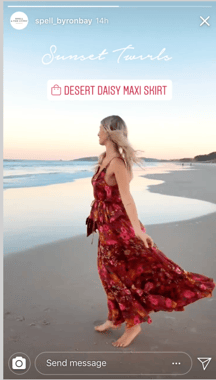Instagram’s user base has grown consistently in recent years, bringing the social network ever closer to the top of the Internet ranks.
With over a billion people using the platform every month, companies can no longer ignore its potential. As proof of this, 80% of users follow at least one of the social network’s 25 million business profiles. And 75% of those respond in some way (like visiting the official site) after seeing a business post.
In response to this new behavior and in order to keep the traffic within its own environment, the app has gone through some huge changes, the greatest of which is the function allowing sales through the platform itself.
How are products sold on Instagram?
There are three ways for vendors to offer products for sale on the social network:
Publication
Vendors create posts about their products, showing prices on the image or in the description. For that format, Instagram offers “pins” that allow the user to tap the image and be redirected to a site to complete the purchase.

Example of a post with counterfeit products being sold on Instagram.
Instagram Stories
Independent campaigns or products may be placed in Stories. When users drag the screen upward, they are redirected to the store’s site and may purchase the product or get more information about the item being advertised.
 Sales in Instagram Stories.
Sales in Instagram Stories.
"Explore" tab
This resource is still in its testing phase, and will function as a window display under the Explore tab. In it, a variety of publications with advertised products will be shown, in the same way that other themes are shown in the tab.
 Instagram’s new shopping spot feature will connect publications with advertised products.
Instagram’s new shopping spot feature will connect publications with advertised products.
Whatever the means for displaying products, users can choose to interact with the desired item and be redirected to the sales channel to complete their shopping excursion. And the results have proven very significant: An estimated 72% of Instagram users have already purchased something they saw on the social network. The issue is this: What you see is not always, in fact, what you bring home.
I discovered pirated versions of my trademarked product. Now what?
Fake products on Instagram are detected using the same procedure detailed in our article on how your company can fight Internet piracy: You must maintain constant vigilance and always be on the lookout for suspicious patterns related to price, stock, product photos and similar factors.
But in the case of social networks, there are two points that deserve further attention. The first is the seller’s profile, since scammers often use the company name or logo along with variations on words such as “official,” or “outlet” in their attempt to create a sense of security for the user. The second point has to do with seasonal promotions such as Black Friday, Christmas or Mother’s Day. The number of scams usually increases at those times, in order to trap unwary consumers.
How does Instagram define counterfeiting?
Instagram’s definition of counterfeiting may be found at the social network’s Help Center. It’s specified there, for example, that selling replicas or imitations of products from other companies is considered infringement, even if the seller makes it clear that the item is not an original or if its origin is omitted.
How can I report a counterfeit on Instagram?
The social network has a form for registering complaints regarding fake products. First, you are informed about the legal considerations regarding counterfeits and the consequences of an erroneous and/or unfounded complaint. Then your contact information is requested, including:
- Who owns the trademark (Here you should report if it belongs to you, to your company, your client or another individual.)
- Your name or that of the company you are representing
- Your position
- Address
- Phone
- Trademark holder’s name
- Link to the trademark’s official page (social network profiles)
It’s important to remember that a portion of this data will be sent to the owner of the content that is in violation. Therefore, protect your privacy by using only the institutional data of your trademark, such as the legal email, business address and phones. After entering your contact information, the page will request trademark information:
- The trademark registration
- Where the trademark is registered
- The category of the trademark’s goods or services
- A direct URL link to the trademark’s registration (if available)
- Attachments (copy of the trademark’s registration certificate)
You may also enter additional trademarks in this section if necessary. Just check the box “I have additional trademarks,” and enter the information of each in the boxes that appear. Finally, you need to enter information regarding the content you wish to report. You may select:
- The type of content (photo/video, caption/comment or profile)
- Any additional information related to the complaint.
It’s important to note that this is a legal process and that, under penalties of perjury in terms of the law, you are declaring that you are either the holder of the trademark or a representative authorized to register these complaints. You will also be responsible for ensuring that all the information in the notification is true.
So the complaint’s been registered. What happens next?
Instagram will analyze your complaint, and if they believe it makes sense, they will remove the content or close the offending account. But it is important that you understand that the actions taken by Instagram are applied only to the fraudulent profile on the social network. That is, external sites or e-commerce businesses (to which the fake publications redirect) are not impacted.
To take action in those channels you will need to do a takedown. This is possible only with active monitoring of unauthorized sales channels, whether internally or with a solution such as Axur’s. With it, it’s possible to monitor and take action in diverse marketplaces, social networks and e-commerce businesses via the Internet. It’s quick and convenient, and has the highest cost-benefit ratio on the market.
.png?width=1214&name=Group%201%20(1).png)


.png?width=841&name=LP%20guia%20(EN).png)

